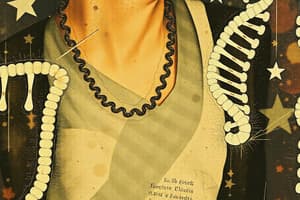Podcast
Questions and Answers
Which nitrogenous base pairs with Guanine in DNA?
Which nitrogenous base pairs with Guanine in DNA?
- Cytosine (correct)
- Uracil
- Adenine
- Thymine
What are the main components of the DNA backbone?
What are the main components of the DNA backbone?
- Phosphate molecules and deoxyribose sugars (correct)
- Lipids and proteins
- Amino acids and phosphate groups
- Ribose sugar and nitrogenous bases
What is the primary role of transcription in the cell?
What is the primary role of transcription in the cell?
- To replicate DNA
- To synthesize ribosomes
- To translate mRNA into protein
- To form mRNA from DNA (correct)
What occurs during DNA replication?
What occurs during DNA replication?
Which structure represents the smallest unit of biological organization in the given size order?
Which structure represents the smallest unit of biological organization in the given size order?
Transcription specifically occurs in which part of the cell?
Transcription specifically occurs in which part of the cell?
What type of mutation involves a single base change in the DNA sequence?
What type of mutation involves a single base change in the DNA sequence?
Which types of RNA are primarily involved in the translation process?
Which types of RNA are primarily involved in the translation process?
Flashcards
DNA Base Pairing Rules
DNA Base Pairing Rules
Adenine (A) pairs with Thymine (T) and Guanine (G) pairs with Cytosine (C) in DNA.
DNA Backbone Components
DNA Backbone Components
The DNA backbone is made up of repeating phosphate groups and deoxyribose sugar molecules.
DNA Replication
DNA Replication
This process ensures accurate DNA copying before cell division.
DNA Nucleotide Structure
DNA Nucleotide Structure
A DNA nucleotide consists of one phosphate group, one deoxyribose sugar molecule, and one nitrogenous base (A, T, G, or C).
Signup and view all the flashcards
Transcription
Transcription
Transcription is the process of creating mRNA from a DNA template in the nucleus.
Signup and view all the flashcards
Mutagens
Mutagens
Mutagens are agents like X-rays, UV light, or radioactive substances that can change the chemical structure of DNA.
Signup and view all the flashcards
RNA in Translation
RNA in Translation
rRNA is involved in ribosome structure, and tRNA brings amino acids to the ribosomes during translation.
Signup and view all the flashcards
Mutations in DNA
Mutations in DNA
Mutations can alter DNA sequences and lead to changes in protein function. A point mutation is a single base change, while a frameshift mutation involves the addition or deletion of bases, shifting the reading frame.
Signup and view all the flashcardsStudy Notes
DNA Structure and Function
- DNA is composed of nucleotides. Each nucleotide contains a phosphate group, a deoxyribose sugar, and a nitrogenous base.
- Adenine (A) pairs with Thymine (T), and Guanine (G) pairs with Cytosine (C).
- The DNA backbone is formed by the phosphate groups and deoxyribose sugars.
- DNA replication is the process of copying DNA before cell division.
- Specific pairing of nitrogenous bases allows for accurate DNA replication.
DNA Replication and Mutations
- Mutations can alter DNA sequences causing changes in protein function.
- Point mutations involve a single base change.
- Frameshift mutations involve the addition or deletion of bases, changing the reading frame.
RNA Structure and Function
- RNA is composed of nucleotides with a phosphate group, a ribose sugar, and nitrogenous bases (A, U, G, C).
- Transcription is the process in the nucleus that produces mRNA from DNA.
- Ribosomal RNA (rRNA) and transfer RNA (tRNA) are critical for translation.
- Translation occurs at ribosomes.
Biological Structures and Order
- Biological structures ordered from largest to smallest: cell, nucleus, chromosome, DNA, nucleotide.
Roles of Biological Molecules
- DNA stores genetic information and regulates cell activity.
- mRNA carries instructions for protein synthesis.
- tRNA transports amino acids during protein synthesis.
Studying That Suits You
Use AI to generate personalized quizzes and flashcards to suit your learning preferences.




